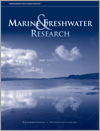Marine and Freshwater Research
Volume 73
Number 11 2022
Examining whether tree morphology and forest structure affect fiddler crab communities, various parameters and characteristics were related to the abundance or presence of these crabs within mangrove-dominated estuaries. Results indicated that mangrove trees influence fiddler crabs indirectly at the population level, by modulating physicochemical and biological variables. Understanding mangrove tree and macrobenthic fauna co-existence patterns will be essential in developing climate-responsive management strategies for these species and the systems within which they occur.
Improving tracking technologies increase our understanding of fish movement. However, common methods calculate spatial metrics differently, and may falsely indicate differences among studies. This study compared two common methods of spatial monitoring and highlighted their differences. It demonstrated the suitability of comparisons between tracking methods, and showed that home-range estimates vary depending on study design and may easily be overestimated.
It is becoming increasingly important to understand coral reef macroalgal assemblages as they continue to rise in abundance globally. Here we surveyed near-shore coral reefs in Kimbe Bay, PNG, to characterise macroalgal assemblage changes with depth and fine-scale distance from shore. We found that the assemblage differed with depth and within an offshore distance of less than 1 km, and total cover was highest at shallow depths.
We determined the C, N and P stoichiometry of two aquatic plants grown in pots subjected to an incident light gradient ranging from 100 to 17% of incident light. Whereas the C, N and P stoichiometry of V. natans and M. spicatum were little influenced across the light gradient, they were more affected by plant organs and species than by light irradiance.
The tomistoma (Tomistoma schlegelii) is a large, slender-snouted crocodilian native to South-East Asia. It is a large species, capable of potentially reaching over 6 m long. On rare occasions tomistomas may attack humans, sometimes fatally. From 2010 to 2020, there have been records from Borneo and Sumatra of 31 attacks on humans that resulted in 10 deaths. This human–tomistoma conflict threatens the future of an already vulnerable crocodilian species.
The south-western North Pacific is one of the main spawning grounds of the Pacific bluefin tuna (Thunnus orientalis) and is targeted by Japanese longline fisheries. Catch-data analysis and age estimation indicate that the spatiotemporal variability of active breeding was influenced by age composition. Furthermore, the age composition in this area influences the recruitment of 0-year-old fish.
This paper models the dispersal of larval spanner crabs to demonstrate that the eastern Australian spanner crab (Ranina ranina) population is dependent on larval supply from the northern region (Queensland). Fluctuations in catch metrics within the southern region (New South Wales) are correlated with a predicted recruitment index. Understanding larval connectivity is vital for cross-jurisdictional fisheries, particularly for species with pelagic larval phases.
Increasing concentrations of sulfate in eutrophic lakes has gained a lot of attention. Cyanobacteria decomposition enhances sulfate reduction leading to the release of sulfide, which inhibits the activities and abundance of microorganisms because of its toxicity. However, in a system with high iron ion concentrations, reducing sulfide is rapidly bound, and its toxic effect on microorganisms is significantly inhibited, thereby eliminating its significant influence on the nitrogen dynamics and nitrogen oxide production.
Sharks are frequently caught as bycatch in the North Aegean Sea; however, little information exists on their biology and ecology. Here, we examined the biological parameters and spatial segregation of sharks using Mediterranean International Trawl Survey data. Females were larger than males, and allometric growth did not share common patterns. Generalised additive models showed that the distribution of common species is bathymetric and geographically dependent. Additionally, depth and geographic segregation patterns were highly associated with ontogeny and not sex.
The golden mussel infestation causes exorbitant ecological and economic disturbances in Brazil, because the species has spread uncontrollably throughout the country. However, this work shows native sponges competing for space, overgrowing and killing the invading mollusc in reservoirs in the Upper Parana River. Understanding the mechanisms involved in this interaction may help control this invasion.
This study re-analysed length-at-age observations of the gummy shark (Mustelus antarcticus), a species endemic to Australia in depths to 400 m. Prior information was used to estimate growth parameters in a Bayesian framework. Like many chondrichthyans (sharks, rays and chimeras), gummy sharks are slow-growing and long-lived. The Queensland population grows slower and to smaller sizes than does the southern population.
Sharks are often observed interacting with caged fish and aquaculture industries. We tracked ∼900 bronze whalers and white sharks to determine whether local shark populations are affected by an aquaculture pen installed for tourism purposes. We found no evidence that sharks were attracted by the pen or stayed in the region for extended periods because of the pen. Good husbandry practices, shallow location, and shark species being migratory likely contributed to the low number of interactions with the pen.





